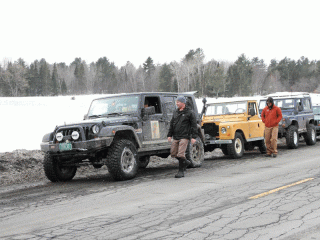For Jeep enthusiasts living in the northeast, winter is the most trying time of year. It’s not so bad around the holidays when there’s a lot of “real life” family stuff to do, but then your heart begins to slowly sink when January rolls around and you’ve not had dirt under tire for two months and there’s nothing ahead but the long winter wheeling blues. What really helps is having a mid-winter off-road event to go to, but such events are pretty rare in the northeast. Enter the Maine Winter Romp, an off-road event like no other.[Not a valid template]
Why is Winter Romp so unique? For many reasons I suppose but I think the main thing is that it’s really a non-event. What’s neat about Romp is that there is no formal organization to speak of. People just show up and figure it out. Yes, there’s some general planning, a website, and a general itinerary but in the end, it’s really more of an organic overlanding get-together than an organized off-road event. And this is by design. You see, the Maine Winter Romp is the brainchild of possibly the most iconic of Land Rover stalwarts you’d ever hope to find: Bruce Fowler.
To begin to understand Bruce is to understand the classic old-school 4×4 enthusiast. To most of us who run fairly modern overland rigs, whether it’s a Jeep TJ or JK, Toyota Tacoma, or modern Land Cruiser or Land Rover Discovery 2 or LR3 or 4, our goal is to have a safe, reliable, road and trail worthy vehicle loaded to the gills with off-road performance modifications, navigation aids, and all the comforts of home.
For Bruce and many like him who cling to the days of yore when you “brung what you got,” it’s about keeping ancient vehicles in various stages of decrepitude going, and just barely at that. Bruce and his band of hard-core, crusty Rover buddies, will think nothing of building up a “series truck” (Land Rover Series 1, 2, or 3; 1948-1984) the week before a gathering and then hitting the road literally while the last few bolts are still being tightened only to find themselves having to resort to extraordinary resourcefulness just getting to the event and back (check out the Riverport Rovers video series on YouTube and you’ll get the idea).
Here’s another example. One year, Bruce was traveling to a major Rover event down in Virginia. He was stiffhitching his 1957 Series 1 with his ’88 Range Rover Classic (yes, a jawdroppingly bad idea to begin with) and the Range Rover’s alternator clapped out smack dab in the middle of I-95 near Washington D.C. Bruce pulled over, scratched his head, and then proceeded to pull the battery from the Series 1, replace it with the dead one from the Range Rover, start BOTH trucks, set the hand throttle in the Series 1, and carry on. When the battery in the Rangie died, Bruce simply repeated the process, allowing the Series 1 to serve as a mobile battery charger. In periods of bumper to bumper traffic, Bruce had to reassure other concerned travelers that he actually meant to have his towed vehicle running while underway.
